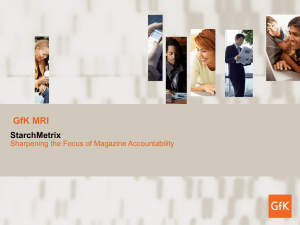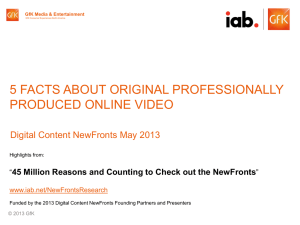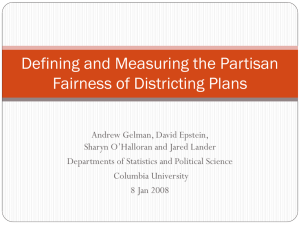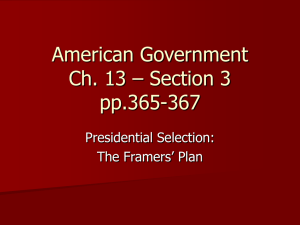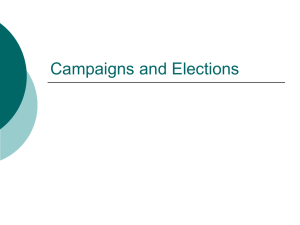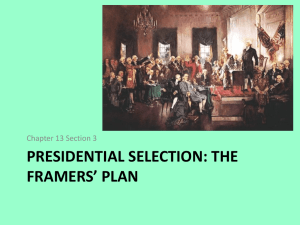PowerPoint
advertisement
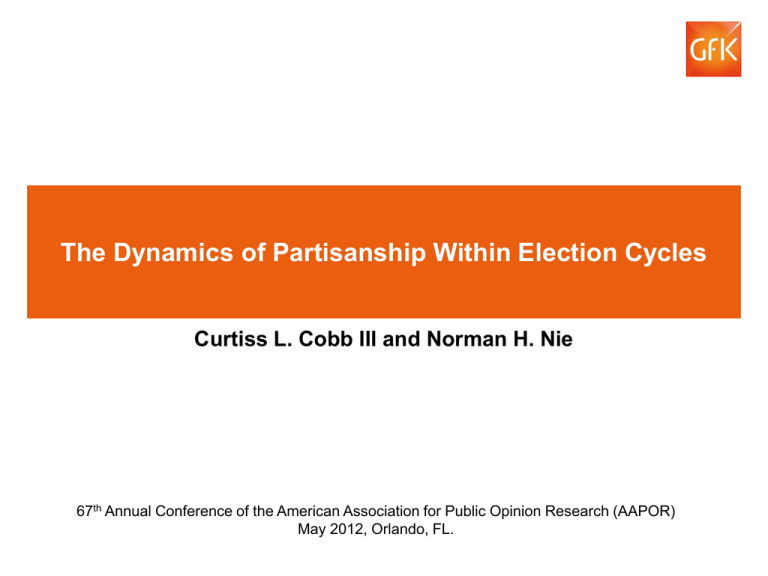
The Dynamics of Partisanship Within Election Cycles Curtiss L. Cobb III and Norman H. Nie 67th Annual Conference of the American Association for Public Opinion Research (AAPOR) May 2012, Orlando, FL. © GfK 2012 | Title of presentation | DD. Month 2012 1 Outline 1. Partisan Identities (PIDs) 2. Possible Impact of Campaigns on PI 3. Study 1; 2008 Presidential Election 4. Study 2: 1978 to 2006 5. Conclusions © GfK 2012 | Title of presentation | DD. Month 2012 2 2 1. Partisan Identities Generally speaking, do you usually consider yourself a Republican, Democrat, an Independent, or what? Would you call yourself a strong [Republican/Democrat] or a not very strong [Republican/Democrat]? © GfK 2012 | Title of presentation | DD. Month 2012 3 3 1. Partisan Identities Psychological self-identification Formed early in life Central orientation from which other dimensions of political attitudes and behaviors emanate (funnel) • Presidential popularity • Support for redistributive policies • Politics and religion • Electoral realignments • Early voting patterns “Normal” vote and defections © GfK 2012 | Title of presentation | DD. Month 2012 4 4 1. Partisan Identities Do political campaigns have systematic, short-term influence on the partisan attachments of voters? Are there demographics factors that influence how much impact campaigns may exert on partisan attachments? Is partisanship more or less stable than other traits, attitudes and behaviors? © GfK 2012 | Title of presentation | DD. Month 2012 5 5 1. Partisan Identities Rational Actor Models • Voters rationally choose the party from which the highest gains are expected • “Cognitive Miser” models • Retrospective voting Stability of Partisan Attachments • Macropartisanship (MacKuen et al. 1989) • 1980 ANES (4-wave panel study) • 1984 ANES (pre- and post-waves) • Partisan Hearts and Minds (Green et al. 2002) © GfK 2012 | Title of presentation | DD. Month 2012 6 6 1. Partisan Identities Stability of Partisan Intensity • 52% of respondents to the 1980 ANES (4-wave panel study) gave the exact same answer in terms of direction and magnitude. • 41% of respondents changed between the pre- and post-waves of the 1984 ANES. • Changes in partisan strength corresponded to changes in vote intention in 1984 using rolling cross-section studies (Allsop & Weisberg 1988) • Green, Palmquist and Schickler re-evaluated the data from each of these studies and many others and conclude that the earlier findings are the result of inadequate measurement model specification. © GfK 2012 | Title of presentation | DD. Month 2012 7 7 2. Possible Impacts of Campaigns Potential Impact of Campaigns on Partisan Intensity Activation © GfK 2012 | Title of presentation | DD. Month 2012 8 8 2. Possible Impact of Campaigns Potential Impact of Campaigns on Partisan Intensity Activation Confusion © GfK 2012 | Title of presentation | DD. Month 2012 9 9 2. Possible Impact of Campaigns Potential Impact of Campaigns on Partisan Intensity Activation No Impact Confusion © GfK 2012 | Title of presentation | DD. Month 2012 10 10 STUDY 1: 2008 Presidential Election © GfK 2012 | Title of presentation | DD. Month 2012 11 3. 2008 Presidential Election Study • Associated Press/Yahoo News 2008 National Election Panel Study • 4,884 adults over the entire course of the 2008 election campaign • 10 interview waves - First wave in November 2007 - Final wave in December 2008 - Each wave re-measured party ID, ideology, and a number of issue questions - Panel approach allows disaggregation of individual-level processes from aggregate trends. - Attention was paid to panel attrition © GfK 2012 | Title of presentation | DD. Month 2012 12 12 55,000+ members Probability-based ABS recruitment Recruitment takes place throughout the year Representative of U.S. adults Includes: Adults with no Internet access (24% of adults) • KP provides laptop and free ISP Cell phone only (30% of adults) Spanish-language Extensive profile data maintained on each member • demographics, attitudes, behaviors, health, media usage, etc. Samples from the panel are assigned to projects • e-mail invitations and a link to the online survey questionnaire © GfK 2012 | Title of presentation | DD. Month 2012 13 13 3. 2008 Presidential Election Aggregate Party ID by Wave © GfK 2012 | Title of presentation | DD. Month 2012 14 14 3. 2008 Presidential Election Number of Partisan Switches © GfK 2012 | Title of presentation | DD. Month 2012 15 15 3. 2008 Presidential Election Number of Partisan Switches Average Number of Switches Democrats All Democrats Strong Democrats Weak Democrats Republicans All Republicans Strong Republicans Weak Republicans Independents Other Party Actual Vote Maintainers Deviators Political Interest High © GfK 2012 | Title of presentation | DD. Month 2012 1.37 1.05 1.89 1.38 1.04 1.85 1.79 1.42 1.23 2.04 Average Number of Switches Political Knowledge High Low Age 18-30 years old 40+ years old Education High School or less College or more Race/Ethnicity White Black Hispanic 1.41 1.89 1.74 1.53 1.75 1.47 1.56 1.64 1.68 1.46 16 16 3. 2008 Presidential Election Transitions Party Identification (t) Party Identification (t-1) Strong Democrat Strong Weak Independe Democrat Democrat nt .855 .110 .029 (.864) (.106) (.026) Weak Republic an .003 (.002) Strong Republic an .002 (.002) Other .001 (.001) Weak Democrat .136 (.146) .708 (.711) .122 (.114) .027 (.023) .003 (.003) .004 (.003) Independent .012 (.010) .047 (.047) .871 (.871) .048 (.050) .014 (.014) .008 (.009) Weak Republican .003 (.000) .021 (.022) .123 (.124) .724 (.735) .126 (.117) .003 (.001) Strong Republican .001 (.001) .003 (.002) .025 (.024) .113 (.101) .855 (.871) .002 (.001) Other .005 (.008) .036 (.017) .246 (.258) .041 (.017) .031 (.008) .641 (.692) © GfK 2012 | Title of presentation | DD. Month 2012 17 17 3. 2008 Presidential Election Percent Reporting Same Party (Direction Only) © GfK 2012 | Title of presentation | DD. Month 2012 18 18 3. 2008 Presidential Election Average Partisan Intensity by Initial Party ID 2 1.8 1.6 1.4 1.57 1.544 1.53 1.421 1.413 1.391 1.411 1.457 1.388 1.444 1.48 1.427 1.487 1.4 1.476 1.413 1.5 1.414 1.477 1.382 1.2 1 0.975 0.8 0.933 0.955 1.06 1.03 1.03 1.04 1.05 0.364 0.34 0.341 0.348 0.315 5 7 8 9 0.99 1.01 All All Democrats All Republicans Independents 0.6 0.4 0.272 0.136 0.2 0.352 0.189 0 0 1 2 3 © GfK 2012 | Title of presentation | DD. Month 2012 4 10 11 19 19 3. 2008 Presidential Election Average Partisan Intensity by Initial Party ID 2 1.8 1.69 1.656 1.578 1.6 1.573 1.678 1.674 1.681 1.712 1.035 1.004 1.645 1.584 1.4 1.2 1.146 1.063 0.938 1 0.8 0.64 0.6 0.875 0.955 0.945 0.723 0.729 0.886 0.698 0.937 0.646 0.804 0.708 0.708 10 11 0.521 0.51 0.4 0.2 0 1 2 3 4 Difference © GfK 2012 | Title of presentation | DD. Month 2012 5 7 Maintainers 8 9 Deviators 20 20 3. 2008 Presidential Election 1. Partisanship appears stable in the aggregate, but a substantial amount of individual-level party identity switching occurred. 2. Switching occurred most during the primary season. 3. Switches occurred least after nominating conventions (when vote intent stabilizes). 4. Net result is that only 82% of respondents give the same party direction in the final wave as the first wave and only 72% given the same direction and strength. 5. Maintainers are stable, while deviators are not. © GfK 2012 | Title of presentation | DD. Month 2012 21 21 3. 2008 Presidential Election Is partisanship more stable than other traits? Alpha Lower Bound Upper Bound Scale Type Scale Points W George W. Bush—Job Approval .8551 .8382 .8680 O 5 5 Iraq War—Favor/Oppose .8533 .8347 .8698 O 4 2 Ideology—Liberal/Conservative (7pt) .8521 .8390 .8641 O 7 5 Party Identity—Direction and Strength .7886 .7661 .8099 N 6 10 Ideology—Liberal/Conservative (5pt) .7764 .7541 .7969 O 5 4 Party Identity—Direction Only .7702 .7481 .7925 N 5 10 George W. Bush—Favor/Unfavor .7674 .7430 .7921 O 5 9 Bill Clinton—Favor/Unfavor .7517 .7279 .7762 O 5 5 Hillary Clinton—Favor/Unfavor .7428 .7184 .7667 O 5 9 Democratic Party—Favor/Unfavor .7281 .7012 .7551 O 5 8 Sarah Palin—Favor/Unfavor .7099 .6860 .7348 O 5 4 Republican Party—Favor/Unfavor .6901 .6611 .7219 O 5 8 Party Identity—Strength Only .6802 .6400 .7187 O 2 10 Vote Intent .6704 .6374 .7006 N 4 5 Party Identity—Independent Leaners .6621 .6271 .7014 N 3 10 Barack Obama—Favor/Unfavor .6535 .6270 .6807 O 5 9 Joe Biden—Favor/Unfavor .6460 .6167 .6748 O 5 4 Nancy Pelosi—Favor/Unfavor .6382 .6058 .6721 O 5 5 Michelle Obama—Favor/Unfavor .6118 .5797 .6431 O 5 5 Item © GfK 2012 | Title of presentation | DD. Month 2012 22 22 4. 1978 to 2006 • 161 public opinion polls from 1978 to 2006 • Publically available • Nationally representative sample • Sample size of n=1,000 or more • “Michigan” series of questions • Over 400,000 respondents • 4-year election cycle broken into 16 quarters • Control for “house effects” © GfK 2012 | Title of presentation | DD. Month 2012 23 23 .75 .8 .85 .9 .95 4. 1978 to 2006 0 2-AMJ 1-JFM 4-OND (no election) 3-JAS 5-JFM 6-AMJ 8-OND (Congress) 7-JAS 9-JFM 10-AMJ 12-OND (no election) 11-JAS 13-JFM 14-AMJ 16-OND (Pres) 15-JAS Political Quarter Partisan Strength © GfK 2012 | Title of presentation | DD. Month 2012 95% CI 24 24 5. Conclusions 1. Campaigns and elections lead a substantial amount of individual-level partisan change. 2. Partisan change occurs systematically in relation to events, candidates and issues. 3. Partisanship is no more stable than other attitudes. 4. This is theoretically satisfying. © GfK 2012 | Title of presentation | DD. Month 2012 25 25 Thank you! curtiss.cobb@gfk.com Curtiss L. Cobb III is Director of Survey Methodology at GfK. Norman H. Nie is Professor Emeritus of Political Science at the University of Chicago and Stanford University, and co-founder of Knowledge Networks, now a GfK company. © GfK 2012 | Title of presentation | DD. Month 2012 26

